
Meta Description: Discover the top 12 AI tools for content marketing in 2025. Our review covers text generation, SEO, video, and more to help you scale your strategy.
Are you struggling to keep up with the relentless demand for high-quality content? It's a common challenge for marketers and creators alike. The pressure to consistently produce engaging blog posts, social media updates, and optimized landing pages can lead to creative burnout and missed deadlines. Juggling multiple platforms for writing, design, and analytics only adds to the complexity, making it difficult to maintain a cohesive and effective strategy.
This is where the right AI tools for content marketing become a game-changer. By automating repetitive tasks, generating creative ideas, and providing data-driven insights, these tools act as a powerful extension of your team. This guide will walk you through the best platforms available, helping you find the perfect solution to streamline your workflow, overcome writer's block, and scale your content production without sacrificing quality.
1. Media Workbench AI
Media Workbench AI establishes itself as a commanding force among ai tools for content marketing, delivering a unified and powerful suite for creators who demand versatility and efficiency. It moves beyond single-function generators by integrating text, image, code, chat, voiceover, and video creation into one cohesive dashboard. This all-in-one approach is its core strength, eliminating the need for digital agencies and marketers to juggle multiple subscriptions and disparate workflows. The platform is engineered to serve as a central content operations hub, from initial brainstorming to final analysis.
Why Media Workbench AI is a Top Choice
What truly sets Media Workbench AI apart is its incredible breadth of functionality combined with user-centric design. While many tools focus solely on text, this platform leverages premier AI models like GPT and DALL·E to offer a full spectrum of multimedia content creation. Its library of hundreds of pre-built, customizable templates is a significant asset, providing structured starting points for everything from social media updates and complex email campaigns to SEO-optimized blog posts and product descriptions. This feature dramatically accelerates content velocity for busy marketing teams.
Practical Use Cases
- For Digital Agencies: Manage multiple client accounts from a centralized dashboard. Use the templates to quickly generate campaign assets, from ad copy and social media visuals to video voiceovers, ensuring brand consistency and rapid turnaround.
- For Content Marketers: Leverage the SEO tools for keyword research and content optimization. Use the AI writer to overcome writer's block and draft long-form articles, then use the image generator to create custom visuals that complement the text.
Pros:
- All-in-One Solution: A comprehensive suite for generating text, images, code, chat, and voiceovers.
- Extensive Templates: Hundreds of customizable templates for marketing, social media, and SEO.
- Affordable & Flexible: Low entry price point with a free trial and money-back guarantee.
- Robust Dashboard: Features analytics, user insights, and integrated support ticket management.
Cons:
- Learning Curve: Newcomers to AI may need time to explore all the features.
- Tiered Features: Some advanced capabilities are locked behind the Premium plan.
Website: https://mediaworkbench.ai
2. Jasper AI
Jasper AI is one of the most established and powerful AI tools for content marketing, positioning itself as an advanced co-pilot for high-performance teams. It excels at generating persuasive, human-like copy for various channels, from long-form blog posts and marketing emails to social media updates and ad copy. Its standout feature is the "Brand Voice," which allows you to upload documents, paste text, or scan your website to create a reusable voice profile, ensuring all generated content remains consistently on-brand.

Core Features & Use Cases
Jasper’s extensive template library (over 90+) provides a structured starting point for virtually any content task. For a digital agency, this means you can quickly draft a client’s entire monthly social media calendar or outline a series of SEO-optimized blog posts. The direct integration with Surfer SEO is a significant advantage, allowing you to optimize content for target keywords directly within the Jasper document editor, streamlining your workflow.
Pros & Cons
Pros:
- Produces exceptionally high-quality, persuasive, and natural-sounding content.
- Maintains brand consistency effortlessly with its Brand Voice feature.
- Seamless integration with essential marketing tools like Surfer SEO and Grammarly.
Cons:
- Can become repetitive if prompts are not detailed enough.
- Higher price point compared to many other AI writing assistants on the market.
Website: https://www.jasper.ai/
3. Copy.ai
Copy.ai positions itself as a versatile and accessible AI partner for marketers and teams looking to streamline content creation without a steep learning curve. It leverages advanced AI to help users generate a wide variety of marketing materials quickly, moving from initial idea to finished copy in minutes. Its strength lies in its extensive template library and a straightforward user interface, making it one of the most approachable AI tools for content marketing, especially for those new to AI-powered writing.
Core Features & Use Cases
With over 90 pre-built templates, Copy.ai provides structured solutions for common marketing tasks like writing social media ads, website copy, product descriptions, and blog post intros. For a startup or small business, this means you can rapidly generate multiple versions of ad copy for A/B testing or create compelling email subject lines to boost open rates. The platform also supports a customizable brand voice and offers robust collaboration features, allowing multiple users to work together on projects seamlessly.
Pros & Cons
Pros:
- Generous free plan with a 2,000-word limit, making it highly accessible.
- Simple and intuitive user interface is ideal for beginners.
- Excellent for team collaboration with unlimited projects and user seats on paid plans.
Cons:
- The user interface, while simple, lacks the advanced feel of some competitors.
- Automation capabilities and workflow integrations are more limited compared to enterprise-focused platforms.
Website: https://www.copy.ai/
4. Writesonic
Writesonic positions itself as a versatile AI-powered content creation platform designed to help marketers and businesses generate high-quality, SEO-optimized articles, ads, and landing pages with speed and efficiency. It stands out by combining AI writing with built-in research and optimization tools, making it a comprehensive solution for producing content that aims to rank. Its ability to analyze competitor content in real-time gives users a strategic edge, ensuring their output is not only well-written but also contextually relevant and competitive.
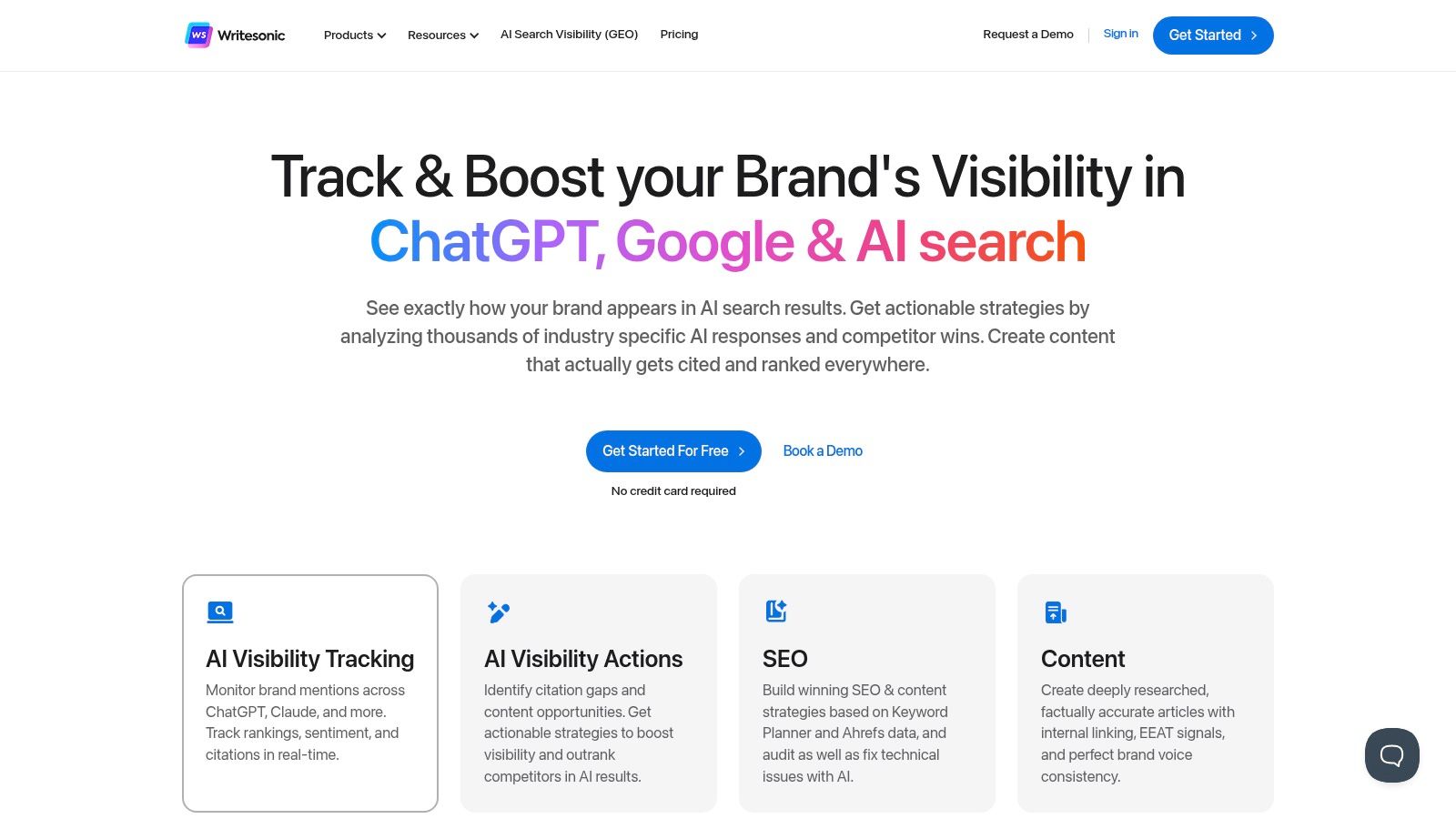
Core Features & Use Cases
Writesonic's suite is built for practical content workflows. Its flagship feature, the AI Article Writer, can generate a full blog post from a single topic idea, complete with research and citations. For a content marketing team, this streamlines the entire drafting process. The platform also includes Photosonic for AI image generation and Chatsonic for a conversational AI experience with up-to-date Google data, making it a powerful hub among AI tools for content marketing.
Pros & Cons
Pros:
- Excellent for generating long-form, SEO-friendly articles with minimal input.
- Real-time competitor insights and data integration provide a strategic advantage.
- Supports a wide range of content types and over 30 languages.
Cons:
- Content still requires careful fact-checking, especially for technical or niche topics.
- Some of the most powerful features are locked behind the higher-priced subscription tiers.
Website: https://writesonic.com/
5. Surfer SEO
While many AI tools focus on creating content from scratch, Surfer SEO specializes in optimizing it to rank on search engines. It's a powerful, data-driven content intelligence platform designed to help you analyze and refine your articles for top SERP performance. By reverse-engineering what's already working for the top-ranking pages, Surfer provides a clear, actionable roadmap to outrank your competitors, making it one of the most essential ai tools for content marketing focused on organic growth.

Core Features & Use Cases
Surfer’s core is its Content Editor, which provides real-time feedback on your writing. It generates a "Content Score" based on factors like keyword density, word count, readability, and the inclusion of important terms and phrases found in top-ranking content. For a content marketing team, this means you can provide writers with a precise, data-backed brief or paste an existing draft into the editor to see exactly what needs to be changed to improve its SEO potential.
Pros & Cons
Pros:
- Provides excellent, real-time analysis and actionable feedback.
- Integrates directly with Google Docs, WordPress, and AI writers like Jasper.
- Supports multiple languages, making it great for international SEO campaigns.
Cons:
- Does not offer a free plan, making the entry point a paid commitment.
- AI-suggested terms and headings require human fact-checking and refinement.
Website: https://surferseo.com/
6. HubSpot
HubSpot has evolved from a CRM leader into an all-in-one marketing powerhouse, embedding powerful AI tools for content marketing directly into its ecosystem. It is designed for businesses seeking a unified platform to manage their entire customer lifecycle, from lead generation to content engagement and conversion. HubSpot's AI features, branded as Content Assistant, help marketers draft blog posts, create social media copy, and generate marketing emails efficiently within the same environment where they track customer data.
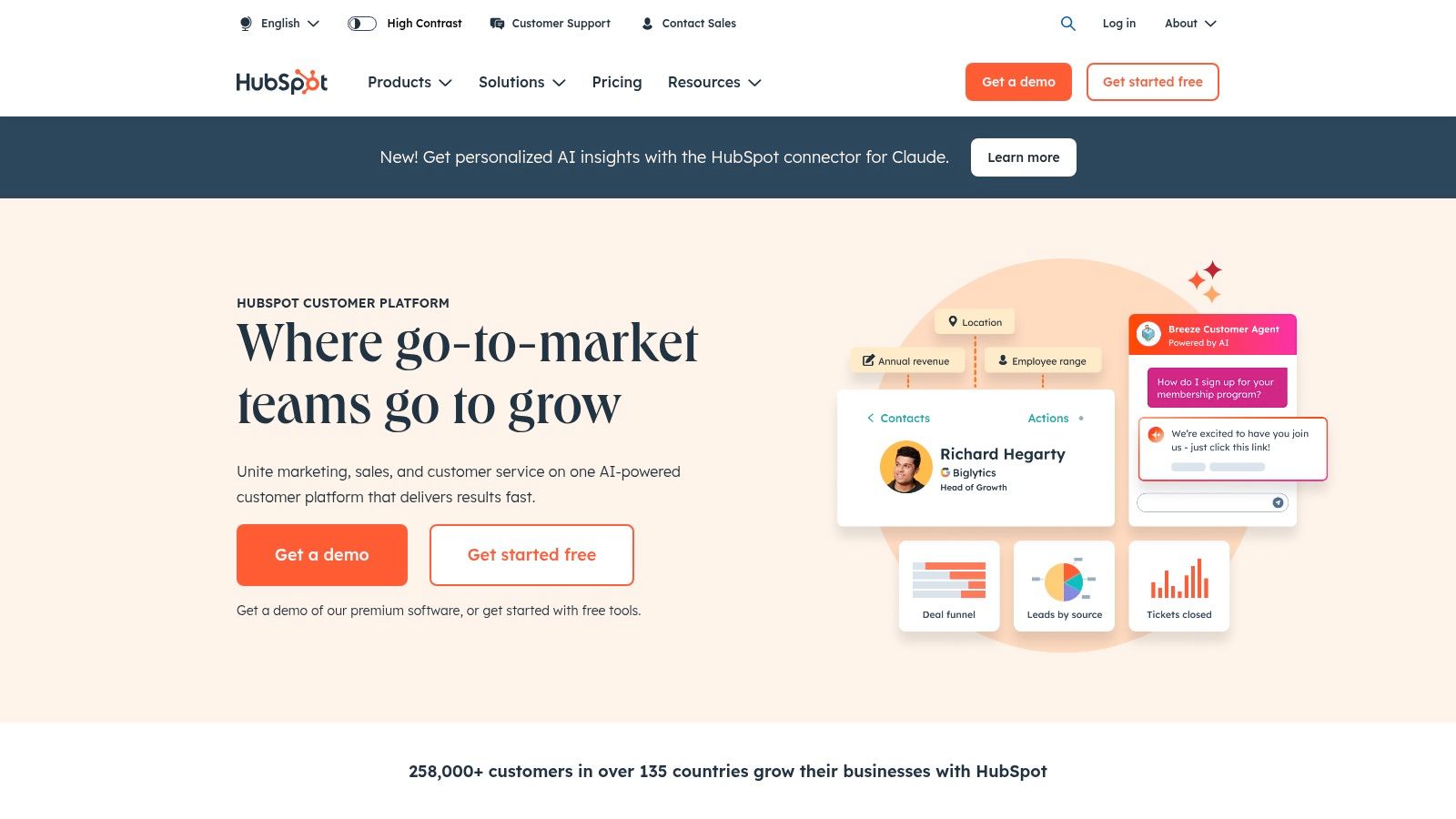
Core Features & Use Cases
HubSpot's strength lies in its deep integration. A marketer can use the AI to generate a blog post outline, then write the full draft while receiving real-time SEO recommendations to improve its ranking potential. The platform connects this content directly to marketing campaigns, landing pages, and the CRM, allowing for highly personalized content experiences based on a lead's behavior and profile data. This makes it an ideal solution for executing complex, data-driven content strategies.
Pros & Cons
Pros:
- Comprehensive marketing suite combining AI content tools with CRM and analytics.
- Extremely user-friendly interface with extensive educational resources.
- Powerful integration capabilities connect content directly to sales and service activities.
Cons:
- The cost can be high, especially for teams needing advanced features.
- The sheer number of features may present a learning curve for new users.
Website: https://www.hubspot.com/
7. MarketMuse
MarketMuse shifts the focus from simple AI content generation to AI-powered content strategy and intelligence. It’s an advanced platform designed to help marketers build topical authority by analyzing their entire website, identifying critical content gaps, and providing data-driven blueprints for what to create next. Rather than just writing, MarketMuse tells you what to write about to dominate a niche, making it one of the most strategic AI tools for content marketing.
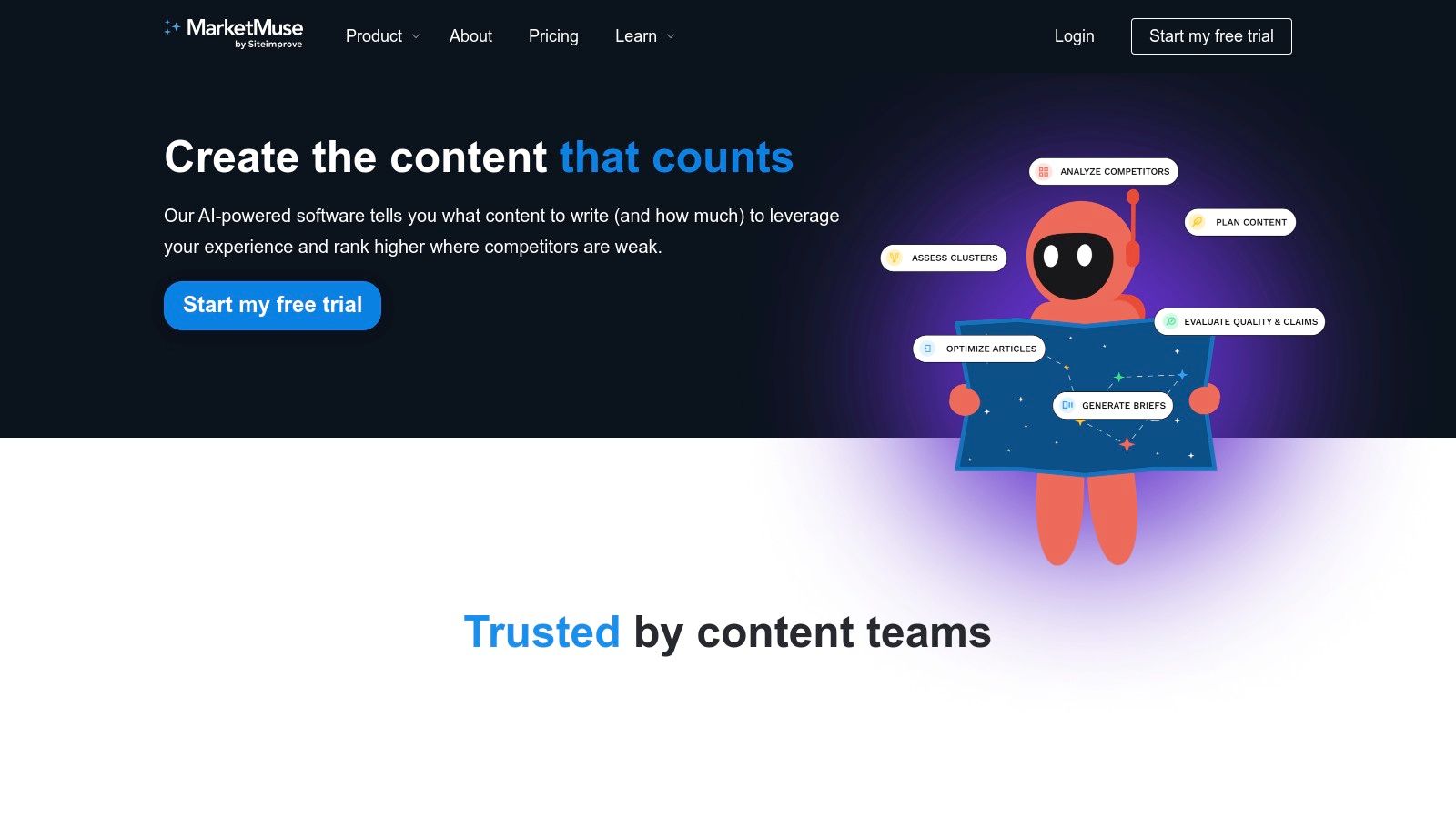
Core Features & Use Cases
MarketMuse excels at topic modeling and competitive analysis, showing you exactly how your content stacks up against top-ranking pages and where you can gain an edge. For a digital agency aiming to establish a client as a thought leader, the platform can build a complete content plan, prioritizing topics that offer the highest potential for impact. Its content briefs provide writers with detailed, SEO-optimized outlines, including recommended subheadings, questions to answer, and internal/external linking opportunities.
Pros & Cons
Pros:
- Provides strategic, long-term content planning based on comprehensive data.
- Offers powerful topic modeling to build deep topical authority.
- Strong competitive analysis capabilities highlight clear opportunities.
Cons:
- Has a steep learning curve and requires a significant time investment to master.
- Higher cost compared to simpler keyword research or content optimization tools.
Website: https://www.marketmuse.com/
8. Lumen5
Lumen5 transforms static text into dynamic video, positioning itself as one of the most accessible AI tools for content marketing focused on video creation. Its core function is to repurpose existing content, such as blog posts or articles, into engaging social media videos with minimal effort. The platform uses AI to analyze your text, identify key messages, and automatically suggest relevant scenes, images, and video clips from its extensive library, making video production incredibly fast.

Core Features & Use Cases
Lumen5’s primary feature is its powerful text-to-video engine. Simply input a URL or copy-paste text, and its AI populates a storyboard for you. For a content marketer looking to extend the reach of a high-performing blog post, this means creating a shareable video for platforms like LinkedIn, Instagram, or Facebook in minutes, not hours. Customizable templates and branding options allow you to add your logo, watermark, and brand colors to ensure consistency across all visual content. To learn more about how tools like Lumen5 are changing video marketing, check out additional insights on the MediaWorkbench.ai blog.
Pros & Cons
Pros:
- Exceptionally easy to use, requiring no prior video editing experience.
- Perfect for repurposing written content and maximizing its lifespan.
- Large built-in library of stock photos, videos, and music.
Cons:
- Video customization options are somewhat limited compared to traditional video editors.
- The AI-selected media can sometimes be generic and require manual changes.
Website: https://lumen5.com/
9. Anyword
Anyword is a data-driven AI writing platform designed to generate and optimize marketing copy that converts. What sets it apart is its unique focus on predictive analytics. Instead of just generating text, Anyword scores and ranks copy variations, predicting how they will perform with your target audience before you even publish them. This makes it an invaluable tool for performance-focused marketers who need to maximize ROI on their ad spend, email campaigns, and landing page conversions.
Core Features & Use Cases
Anyword's standout feature is its Predictive Performance Score, which provides instant feedback on the persuasive potential of your copy. A digital agency can use this to A/B test ad variations or email subject lines with data-backed confidence, saving time and budget. The platform also offers customizable Brand Voice profiles and pre-built templates for specific channels like Facebook ads, Google ads, and product descriptions, making it one of the most practical ai tools for content marketing when direct response is the goal.
Pros & Cons
Pros:
- Provides data-backed predictive analytics to forecast copy performance.
- Excellent for creating high-converting ad and landing page copy.
- The user-friendly interface makes it easy to generate and compare options.
Cons:
- Can require some manual fine-tuning to perfectly match a very specific brand tone.
- The pricing structure can be a bit high for solopreneurs or very small businesses.
Website: https://anyword.com/
10. Omneky
Omneky is a specialized AI platform that moves beyond text generation to focus on creating and optimizing visual ad creatives for omnichannel campaigns. It uses machine learning to generate personalized ad content at scale, analyzing what resonates with specific audiences across platforms like Facebook, Google, LinkedIn, and TikTok. For performance marketing teams, Omneky acts as an automated creative director, generating visuals and copy combinations designed to drive conversions.
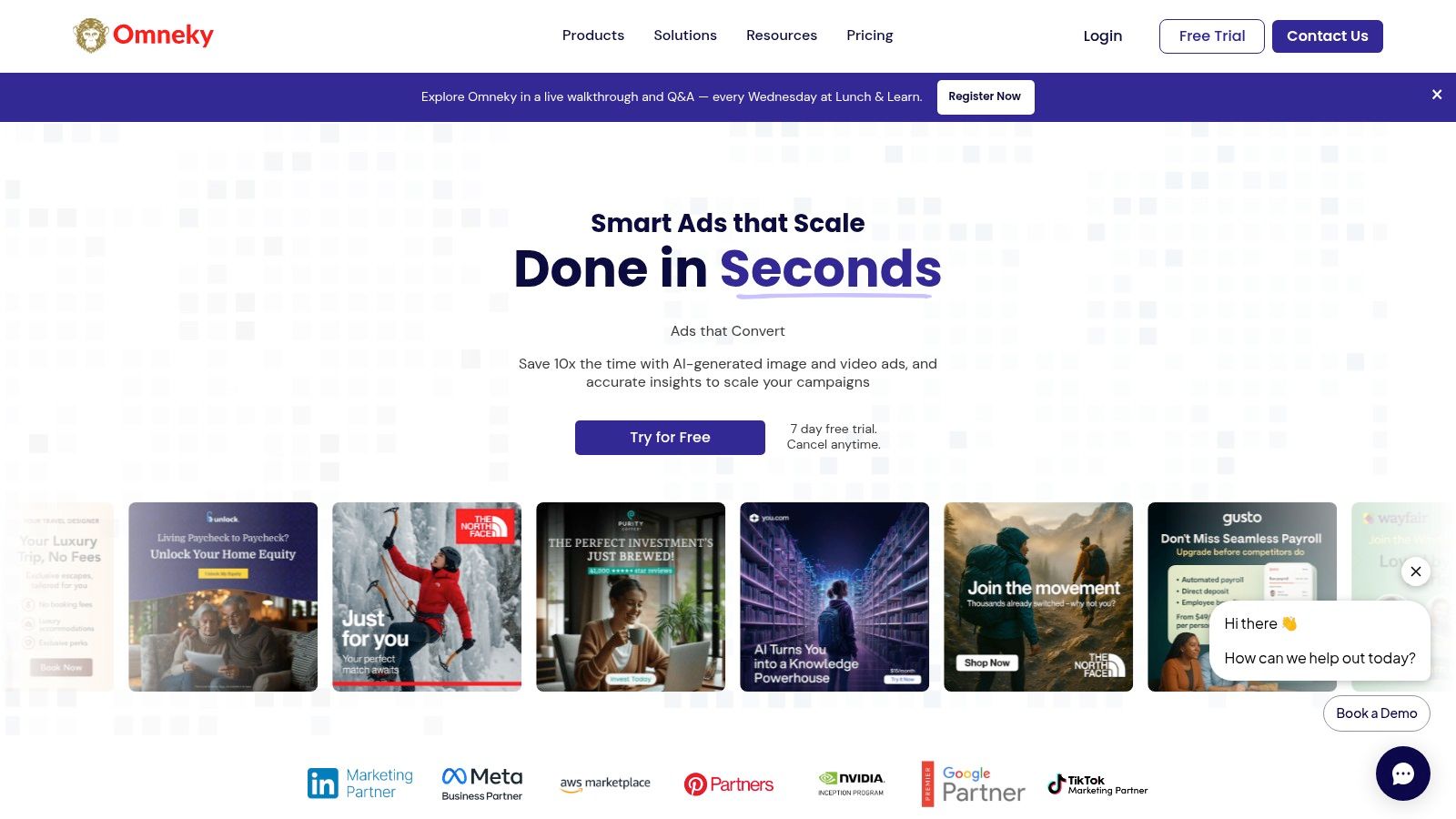
Core Features & Use Cases
The platform's core strength is its ability to connect creative production directly to performance analytics. Omneky ingests your brand assets and campaign data, then generates thousands of ad variations. It continuously analyzes performance metrics to identify winning elements, such as specific imagery, headlines, or calls to action, and then uses those insights to refine future creatives. This makes it an invaluable AI tool for content marketing campaigns focused on paid advertising.
Pros & Cons
Pros:
- Automates the time-consuming process of A/B testing ad creatives.
- Provides data-driven insights to improve ad performance across multiple channels.
- Generates a high volume of personalized ads tailored to different audience segments.
Cons:
- The analytics dashboard can have a learning curve for new users.
- Pricing is not publicly listed and requires a consultation.
Website: https://www.omneky.com/
11. Bloomreach
Bloomreach is a comprehensive e-commerce experience platform that leverages AI to unify marketing automation, content management, and product discovery. While not a standalone writing tool, it stands out as one of the most powerful AI tools for content marketing within the e-commerce sector. It’s designed for businesses aiming to create highly personalized and cohesive customer journeys, from the initial ad click to the final purchase and beyond. Its strength lies in using data to power every interaction.
Core Features & Use Cases
Bloomreach’s platform is built on three core pillars: Engagement, Discovery, and Content. The Engagement pillar offers sophisticated marketing automation, allowing e-commerce marketers to build complex, AI-driven campaigns across email, SMS, and apps. The Discovery pillar uses AI to power site search and product recommendations, ensuring customers find what they want quickly. For content teams, the headless Content pillar allows you to manage and deploy promotional content, banners, and landing pages seamlessly across any channel, all personalized based on user data.
Pros & Cons
Pros:
- An all-in-one suite for e-commerce, combining personalization, marketing, and content.
- Significantly enhances the customer journey with AI-driven product discovery and recommendations.
- Integrates deeply with major e-commerce platforms like Shopify Plus and BigCommerce.
Cons:
- Its complexity and feature depth can be overwhelming for small businesses.
- Pricing is enterprise-focused and not publicly listed, requiring a direct sales inquiry.
Website: https://www.bloomreach.com/en
12. Freepik
While known primarily as a massive stock content library, Freepik has evolved into a powerful creative hub, integrating AI tools that are invaluable for content marketing. It provides an all-in-one solution for marketers who need to generate high-quality visuals, from social media graphics and blog banners to presentation slides, without leaving the platform. Its standout feature is the combination of a vast human-created asset library with new AI-powered generators, giving you the flexibility to either find the perfect image or create it from scratch.
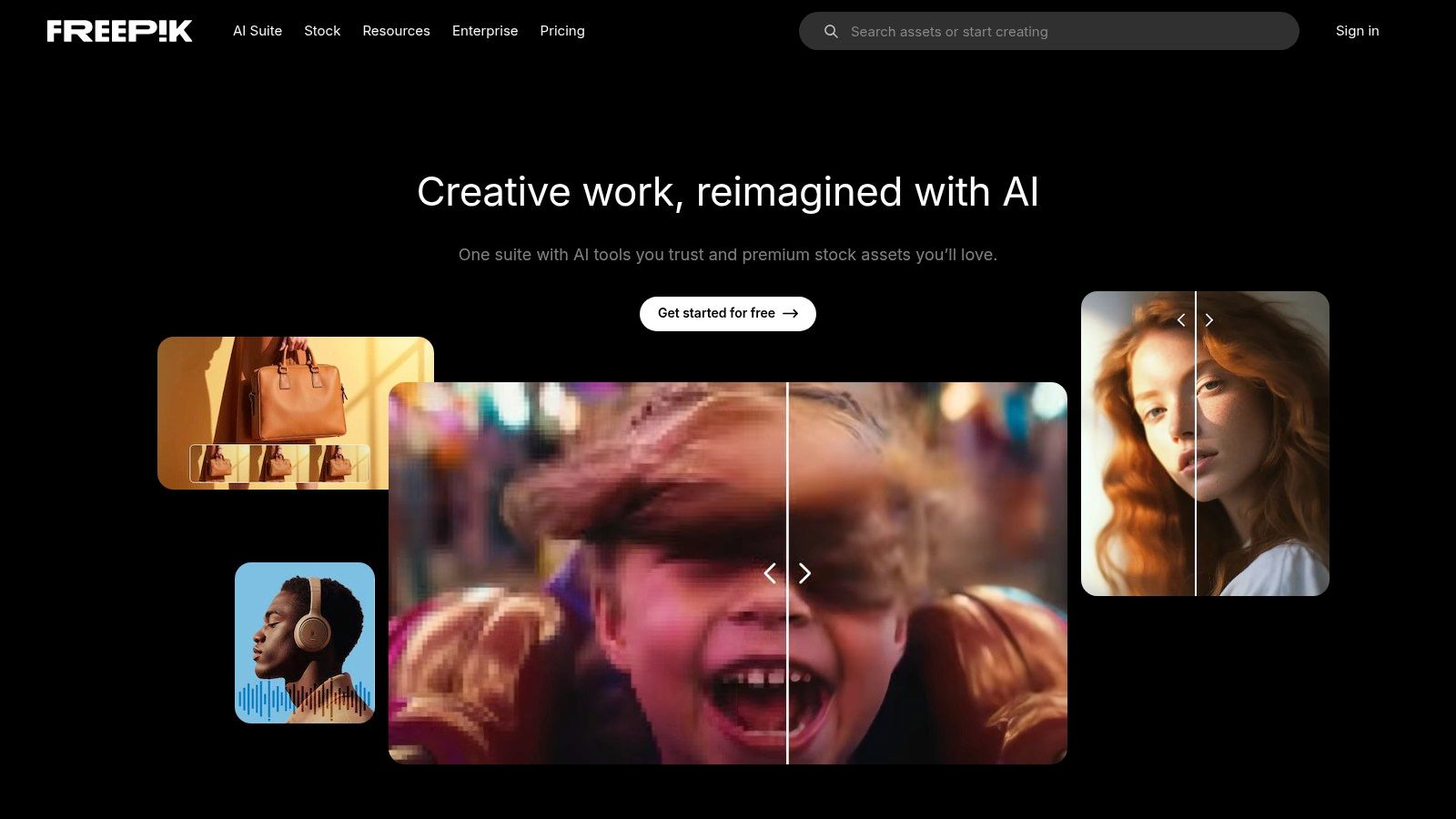
Core Features & Use Cases
Freepik's suite of AI tools is designed to accelerate visual content creation. The AI Image Generator lets you create unique, royalty-free images from simple text prompts, perfect for custom blog headers or unique social media posts that stand out. For agencies, the extensive library of templates, mockups, and vector graphics streamlines the design process for client projects. You can find a stock photo and then use the AI editor to expand the background or remove unwanted objects, merging traditional and generative workflows seamlessly.
Pros & Cons
Pros:
- Massive library of high-quality stock photos, vectors, videos, and templates.
- Integrated AI tools for image generation and editing are intuitive and easy to use.
- Generous free plan makes professional design accessible to everyone.
Cons:
- Free use often requires attribution, which may not suit all brand guidelines.
- Premium assets and unlimited AI generation are locked behind a paywall.
Website: https://www.freepik.com/
👉 Try MediaWorkbench.ai for free – schedule your posts and generate AI content in one place!
Choosing the Right AI Tool for Your Strategy
Navigating the expansive universe of AI tools for content marketing can be overwhelming. As this guide shows, options range from all-in-one platforms like Media Workbench AI to specialized solutions like Surfer SEO for optimization. The key is to identify your biggest bottleneck—is it ideation, writing, or visual creation? A freelance writer might benefit most from Jasper, while a digital agency will find more value in an integrated platform that handles creation, scheduling, and analytics. Before committing to a subscription, assess your specific needs, team size, and budget to build a tech stack that truly supports your goals and enhances your workflow.
These tools are not meant to replace skilled marketers but to act as powerful assistants. They handle the repetitive, data-driven tasks, freeing up your team to focus on strategy, creativity, and building authentic audience connections. By adopting a human-in-the-loop approach, you can ensure your content remains high-quality and strategically aligned with your brand voice.
Ultimately, the journey into AI is about strategic experimentation. Start small, solve a clear problem, and measure the impact. The right combination of tools can dramatically amplify your team's efficiency and creative output.
Ready to streamline your workflow? Explore Media Workbench AI to consolidate your content generation, social media scheduling, and analytics into one smart, intuitive platform.

